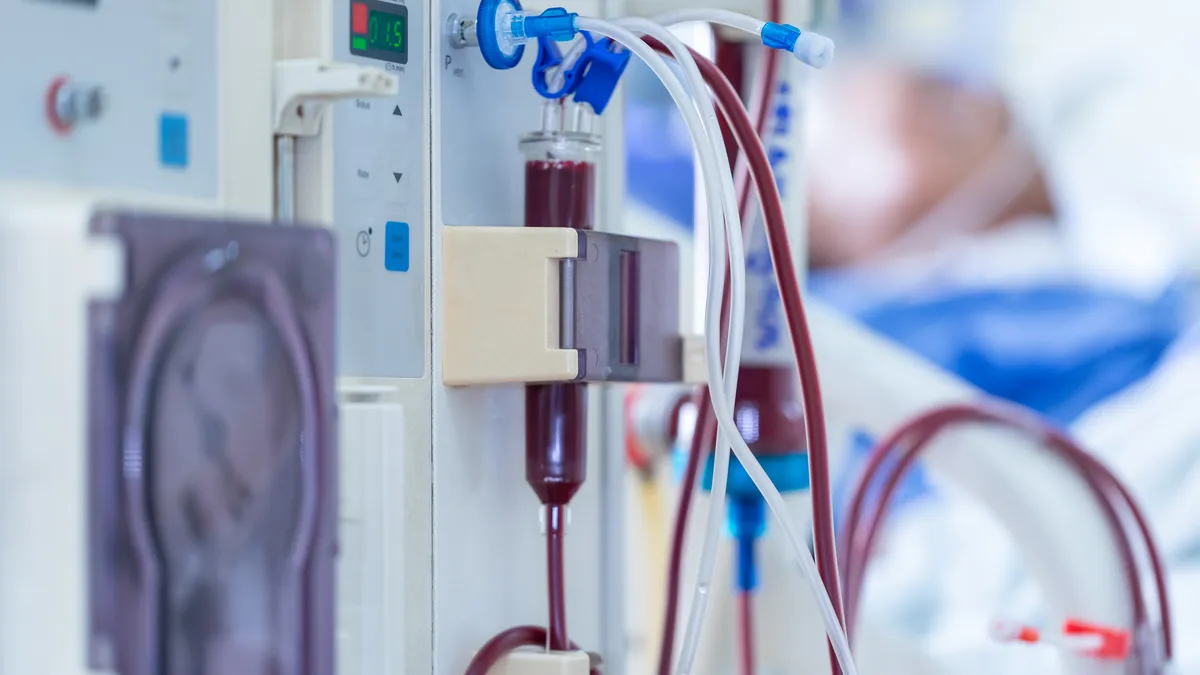Medtech companies are rapidly integrating artificial intelligence into cardiovascular medicine, from imaging and electrocardiology to genetics and patient monitoring. Best practices are still evolving, however, and few AI tools have been shown to improve cardiovascular and stroke care enough to be widely adopted, according to a recent statement from the American Heart Association.
Medtronic is among the device makers working to support earlier disease detection and treatment through AI-enabled technologies. The company told MedTech Dive that better algorithms and sensing technologies and an expansion of available data are improving accuracy and access across multiple specialties. For example, AI is now being used to enhance detection of polyps in real-time during colonoscopies, eliminate finger sticks for calibrating continuous glucose monitors in diabetes management and optimize screw alignment in spine surgery planning.
MedTech Dive recently spoke with Stacey Churchwell, general manager of Medtronic’s cardiovascular diagnostics and services business, to discuss the company’s integration of AI algorithms for detecting abnormal heart rhythms into its insertable cardiac monitors (ICMs). The miniature devices — the latest version is about a third the size of a triple A battery — are implanted under the skin in a patient’s chest to help diagnose abnormal heart rhythms such as atrial fibrillation (AFib).
This interview has been edited for length and clarity.
MEDTECH DIVE: How did Medtronic overcome some of the inherent challenges in developing AI, such as disparities built into algorithms that may reflect bias?
STACEY CHURCHWELL: With regard to AccuRhythm AI, we utilized a large global data repository for training and validation, including not only standard ECGs, but also rare and edge case scenarios, helping us to mitigate biases and ensure the AI's appropriate behavior when deployed in the market. We took active steps to develop additional permutations of data that account for common differences observed across populations.
To prevent the AI from re-learning undesirable habits or biases, we locked its training once our scientists were satisfied with its performance. Before launching the algorithms, we rigorously validated the AI's decisions with human adjudicators to ensure consistency with human decisions.
What is the goal of incorporating AI into the ICM?
We started our journey by improving the specificity of our devices so that we can remove false positives or false alerts that would otherwise create burden for clinics.
An ICM looks for anything abnormal, and it's really designed to be highly sensitive. It's looking for things that don't appear to be normal sinus rhythm, and it's flagging it. Before AI was introduced, there was a potential for things to kind of slip through that may not be clinically relevant or actionable and that would require the care team to have to sift through and look at those alerts to determine and adjudicate whether in fact they're real or not. We've got some great technology on board the device itself, but it's not perfect.
We saw that as an opportunity, and what we have done with AI is to implement it in the cloud. As those signals come in that are deemed to be suspect signals that could be an arrhythmia, that information gets sent up to the cloud where AI sits, into our CareLink network and that AI, which has been trained using millions of data points.
How is AI improving the ability of the device to do its job?
We've been doing this for 26 years. We've got a lot of data on board. We've used that data to train the AI to understand and look for those discrete patterns. It goes through a process of adjudicating those signals to say, “I have high confidence that this is real, I have high confidence that it's not real, or maybe it's borderline.”
When it gets through that filter, we immediately eliminate [false alerts] that we know with high confidence aren’t real. And so the physician, the clinician team, never sees that. We're going to always send forward [signals] that we know are real, but also those things that may be suspect. We're always going to put that in front of the clinician to make the final judgment on. But because the AI is so good, it does a fantastic job of weeding out a lot of that noise that otherwise, before the AI was activated, would have slipped through, and that burden would have been left on the care team to try to figure out.
How well is the AI performing?
We've been really, really thrilled with the results. We hear it from our clinicians that it's making a difference. We’re committed to not compromising on our ability to identify true events. That sensitivity, we try to keep in that 99% range, so that we can say that when we call something AFib, you can take to the bank that it's AFib. You're not going to miss those events that you could have otherwise missed had we compromised on our sensitivity capability.
What we've seen with AccuRhythm AI 2.0 — we launched 2.0 last summer — is that the AFib false alert reduction went from 74.1% to 88.2%. We're taking out even more of that false data.
What is the benefit of being cloud-based?
One, we get to take advantage of the computational power of the cloud, versus burdening the device itself, which would have a battery longevity consequence. The other great benefit is that we get to impact and improve devices that were implanted years ago.
When we flip the switch in the cloud, every device that's still active gets the benefit. Whether we implanted it today, two days ago, two weeks ago, two months ago, two years ago — if that device is still active, it's going to see the benefit of that AI. That clinic is going to see that relief.
Where will you be focusing your AI efforts next?
We think our next frontier is prediction, and one of the things that we have an opportunity to do is to demonstrate that Linq can play a role in facilitating heart failure management.
We've got a big clinical trial underway right now called Alleviate-HF that's exploring that very question, and we'll have results back in about a year’s time that will give us the green light to move forward in commercializing a solution and algorithm that will leverage AI for prediction. Then we can give our customers the heads up that a patient may be headed toward hospitalization, which would give them time to take action and adjust meds to perhaps keep that patient out of the hospital and drive costs out of the system.
When is it best for a heart patient to get an insertable monitor versus a wearable one?
Wearable solutions are considered as a first step. Holter monitors or external patches are generally used for a time period ranging from, say, seven days to 30 days. One of the big hurdles that those technologies have is around patient compliance.
For patients who have more infrequent symptoms, and these could be episodes that happen every two or three months or even six months, you really want to consider something more long term. The great thing about an ICM is it's set it and forget it. It's looking 24/7, and you have up to several years of a window to find what you're looking for.
There's a recent study [Stroke-AF] that showed that 78% of patients who had AFib would have been missed if you only monitor them for 30 days. We know without a doubt that 30 days just isn't enough. That's why we tend to think that ICM is a great solution to consider for those patients.


















